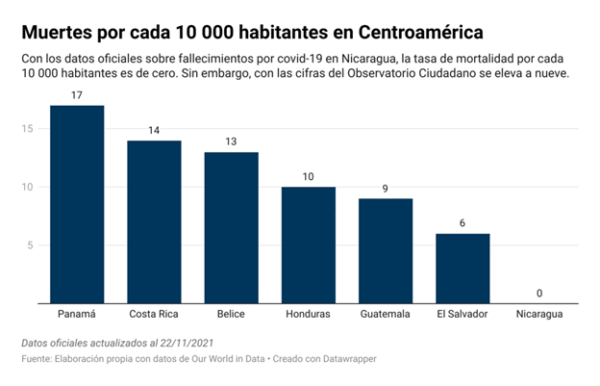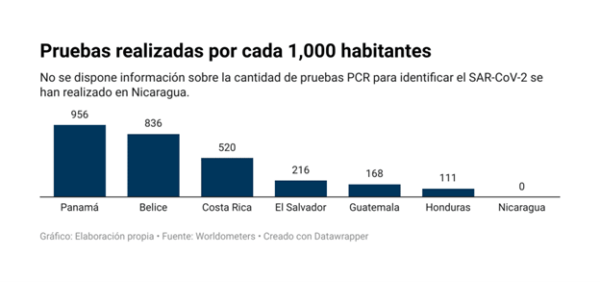Study: Nicaraguan Gov. Hid up to 9000 Deaths from Covid-19

An independent investigation concludes that the Ortega government is responsible for mishandling of the pandemic: official data is opaque and questionable
HAVANA TIMES – A study entitled “Covid-19 and Opacity: Death Data in Nicaragua” concluded that Daniel Ortega’s government hides the number of people infected with covid-19 and deaths, does not perform diagnostic tests and underutilizes funds designated for combating the pandemic.
“The authorities are responsible for initially denying the pandemic, not taking measures, and covering-up their mismanagement, to sell the idea to the population that the State cared about them and did everything possible to save them,” said the study, presented on Friday.
The investigation, carried out by the Observatory for Transparency and Anti-Corruption, pointed out that in Nicaragua there is an estimated 6,000 – 9,000 deaths from covid-19 that are not recognized by the authorities because they were attributed to other causes in order to reduce the statistics of the pandemic.
The calculation of these deaths was based on the studies of excess mortality carried out by the Multidisciplinary Scientific Committee, Covid-19 Citizen’s Observatory, the Nicaraguan Foundation for Economic and Social Development (Funides), CONFIDENCIAL, and also, on official statistics of neighboring countries. In the latter, Nicaragua’s official mortality statistics –the historical trend of deaths– was analyzed and compared with the figures of neighboring countries.
The investigation also pointed out that “official statistics are scarce, confusing, and questioned by the medical community and by the Pan American Health Organization (PAHO),” and that “public data does not allow us to know the most affected groups or the impact on healthcare personnel.”

Minsa’s Low Death Rate
In addition, the researchers point out that the figure of 211 deaths, registered until November 23, is statistically unlikely and is 28 times lower than that of Citizen’s Observatory.
“The data from Citizen’s Observatory reports 1.7 times more suspected cases and 28 times more deaths than those reported by Minsa, whose figure is very low. There is probably an under-registration,” said the researcher in charge of the study, who says that it is unlikely that in Nicaragua exactly one citizen has died every week since October 2020.
However, Citizen’s Observatory data also reveals an under-registration of the number of infections, which is why the deathrate in relation to the number of positive cases of covid-19 in this group is so high: 19%. This is 9.5 times higher than the global percentage of 2%, which Citizen’s Observatory explains as not all asymptomatic and mild cases are reported because only Minsa has the capacity to register them through testing.
The researchers also highlight that while in the rest of the Central American countries between six and eleven people die every week for every 10,000 inhabitants. In Nicaragua, based on official statistics, nobody would die.

To that, the head researcher added that the slim access that exists in Nicaragua to perform PCR tests, the controlling of which is exclusive to the Ministry of Health. The cost is 150 US dollars per test, and they are only available to people traveling outside the country, medical personnel, and extremely ill patients. As a result, according to official figures, Nicaragua reflects the lowest number of infections in Central America.
He pointed out that this reflects the murkiness of the data on covid-19, since in neighboring countries between 956 and 111 PCR tests are given per 1000 inhabitants, whereas in Nicaragua the average is zero.
“The COVID-19 crisis shows the structural weaknesses of the Nicaraguan health system, but also of the ruling political regime characterized by its authoritarianism, secrecy and serious human rights violations that have caused a severe humanitarian crisis, one of the most significant in the region,” he said.
Budget implementation
The study also analyzed implementation of the budget that the Ortega Government has made during 2021 and the loans received to respond to the pandemic, amounting to more than 185.4 million dollars. In these, a low level of implementation predominates, despite the fact that the country experienced a strong wave of contagion and deaths and lagged behind in vaccination coverage during the first ten months of this year.
“The covid budget for 2021 is 5.014 billion córdobas (approx. US $141 million) which is equivalent to 1.0% of the Gross Domestic Product (GDP) and as of September less than 20% has been used,” the report explained.
It also highlights that one of the few investments mentioned by Minsa this year is the improvement of its deep-freezing capacity for vaccines such as Pfizer, that can now be stored. However, there is no detailed information about the funds they used in this investment.
The research also questions why having funds during the first half of 2021 Nicaragua relied almost entirely on vaccine donations and why the only purchases made are from Cuba and Russia, which offer vaccines not authorized by the World Health Organization (WHO). It also highlights that the country has not been transparent even in the vaccination data against covid-19.
“Vaccination statistics are not consistent, nor are they shared in real time. According to PAHO data, Nicaragua went from having 7% of its population fully vaccinated by November 5, to 32% in the report released on November 22. This represents a jump of 250%,” the report reads.
*With information from EFE





